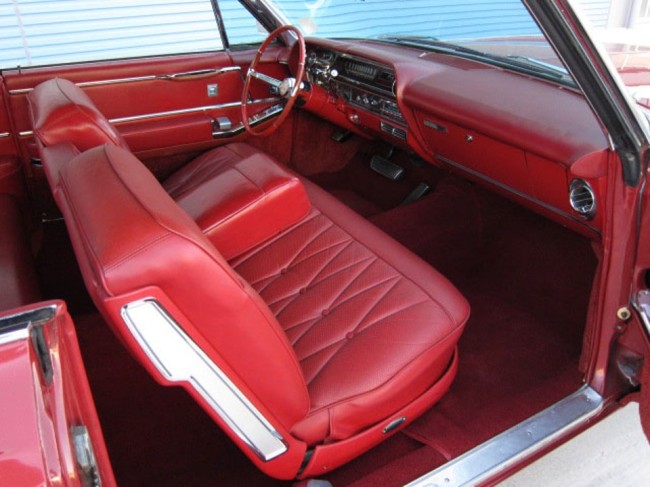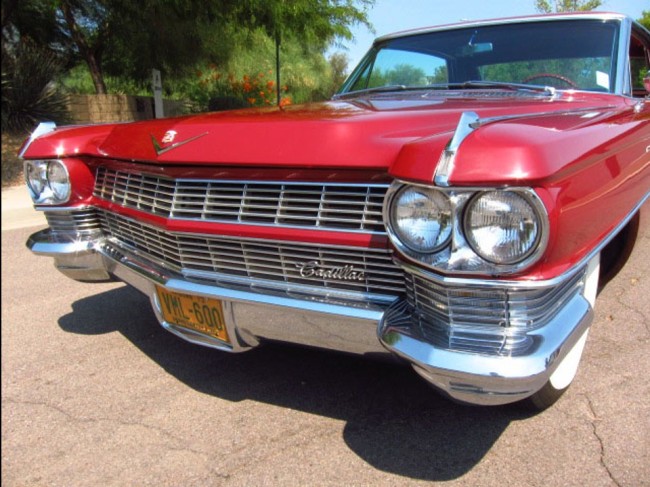1964 Cadillac Coupe deVille
This was the last model year to wear the iconic tail fin
The distinguished classic simplicity of the 1964 Cadillacs made them impressive and exclusive. The Cadillac “Beauty Treatment” refined the elegance of the previous model year to perfection. This was the finale for the iconic Cadillac tail fin. They were once again tapered into the architecture….and for the last time. The glamorous Coupe deVille with its exclusive two-door styling and six passenger comfort was once again America’s favorite luxury car.
It was powered by Cadillac’s all-new V8 engine with larger displacement, more horsepower and higher torque. A new Turbo Hydra-Matic automatic transmission offered silky smooth operation with virtually imperceptible shifting. The 1964 Coupe deVille and its new spirit demanded an encore performance….in the continuing saga of “As the Standard of the World Turns.”
The Coupe deVille for 1964 featured an exclusive roofline. The large rear sail panels and smaller rear window gave the Coupe deVille its own identity. The padded vinyl roof option gave it even more distinction. The intimate two-door design added to the apparent length of the hood and rear deck. The rear styling was definitely definitive.
This was the finale for the iconic Cadillac tail fin, the 1964 model year were the last models to sport them. They were trimmed into the architecture for the last time. From the boldly authoritative Cadillac “sneer” to the symmetry of its sweeping bodylines back to the tapered tail fins, the 1964 Coupe deVille was America’s favorite luxury coupe, reinforcing the “Standard of the World” claim to fame….
The 1964 Coupe deVille had a luxuriously upholstered interior by Fleetwood. It was available in natural grain leather or Dover Cloth with leather, or Dorchester Cloth with leather. Optional front bucket seats with locking center console added a sporting note to Coupe deVille’s interior.
Its youthful two-door styling with six passenger spaciousness made the Cadillac Coupe deVille a perennial favorite among luxury car buyers. Standard equipment included; power windows and power two-way seat, folding center front and rear arm rests, electric clock, heater/defroster, courtesy lighting, and anti-glare inside rearview mirror.
Popular optional equipment for the 1964 model year were: air conditioning, adjustable steering wheel, power door locks, Cruise Control, controlled differential, Guide-Matic headlamp control, remote trunk release, Soft-Ray glass, Twilight Sentinel, and whitewall tires. Cadillac offered more standard and optional features and accessories than any other luxury brand.
For the 1964 model year Cadillac offered the most powerful engine in the history of the brand. Engine torque is the key factor how well the vehicle responds to a tap to the accelerator pedal. There was a new spirit in performance to please the conservative owners and spectacular new performance to entice those who always wanted Cadillac prestige and stature. The all-new 429 CID 16-valve OHV V8 engine produced 340 hp @ 4,600 rpm with 651 Nm of peak torque @ 3,000 rpm. Performance was rated as 0-60 mph in 8.5 seconds, 0-100 mph in 23.5 seconds with a top speed of 121 mph. It did the ¼ mile @ 86 mph in 16.4 seconds.
The 429 CID was a brilliantly refined Cadillac V8 engine. The pistons were larger in diameter than the 1963 version, they also weighed less. The crankshaft was also re-designed with larger main bearings for smoother performance and longer life. The combustion chambers were larger and wedge-shaped with a large cooling area at the vortex of the wedge which also prevented pre-ignition power waste. These larger combustion chambers were refined for optimum air/fuel mixture burning. The compression ratio was adjusted to 10.5 to 1 with the use of contoured piston heads increased the turbulence to assure maximum combustion of the air/fuel mix.
An engine’s power output efficiency is governed by how well it breathes. For the 1964 model year the all-new 429 CID V8 used a camshaft which was designed to hold the exhaust valves open longer than the intake valves. This wide, super-hard camshaft had friction resistant cam and bearing surfaces to minimize wear to cams and tappets.
The exhaust manifold was enlarged along with a single exhaust system with more complete evaporation of corrosive acids. The engine was equipped with a 4-bbl downdraft carburetor with automatic choke for efficient engine warm-up and smoother idling, a mechanical fuel pump, intake silencer, hydraulic valve lifters, and polyurethane air filter. Cadillac engines provided double fuel filtering to remove impurities or water that would affect engine performance.
This brilliant new powerplant was mated to GM’s Hydra-Matic (Jet-away) 4-speed automatic transmission. The power was transmitted through an oil filled torque converter that multiplied engine torque during acceleration……thrust is substantially increased up to four-five times by the transmission during acceleration. It took very little pressure on the accelerator pedal to make the engine perform.
The 1964 Coupe deVille was built as body on frame construction using Cadillac’s rugged tubular center X-frame. The wide shallow front frame sections permitted a low front floor and transmission tunnel increasing seat height and headroom. It rode upon a long 129.5” wheelbase and had the luxury length of 223.5” with a wide 79.7” stance. Cadillac’s front suspension design allowed the front wheels to turn at a sharper diameter without restriction which in turn added to its overall maneuverability.
This unique suspension used rubber mounted strut rods extending from each front wheel through the front frame cross member. These strut rods held the wheels in firm fore/aft alignment yet when uneven pavement was encountered they would permit a slight rearward deflection of the wheel to cushion the impact.
Any other road noise, vibration, or shock was absorbed by rubber bushings and mountings between all moving suspension members and the frame. Wedge shaped limit bumpers permitted maximum vertical travel of the wheels cushioning any impact or bottoming out. The front suspension also used upper and lower control arms with spherical joint and independent helical coil springs.
The rear suspension used the Cadillac four-link drive with two lower control arms to hold the axle within alignment preventing sideways motion. The yoke was mounted at high points of the frame and at the top of the rear axle housing resulting in more weight below this point which contributed to a level ride with less outward lean on curves. Rubber bushings isolated road noise and absorbed impact between frame and suspension members. Wedge shaped limit bumpers allowed increased wheel travel and softer cushioning in case of bottoming out. Cadillac gas-filled shock absorbers were fitted to the front and rear.
Cadillac’s triple-braking system was standard. The system used a dual hydraulic master cylinder with separate fluid reservoir for front and rear systems providing independent operation. The parking brake could be used as a true auxiliary brake, it had an automatic release that wouldn’t allow it to lock with the engine running and in gear.
The self-adjusting brake shoes automatically returned brake linings back to proper clearance when car was driven in reverse and the brakes applied. Finned front and rear brake drums provided increased air flow dissipating heat faster. The front brakes had splash protection by a specially designed flange on the front backing plates that shielded the interior drums from water. The wheel brake cylinders were made of iron alloy and were self-lubricating with long-life pistons.
Also standard was Cadillac’s power steering. It required the lightest touch. The steering shaft housed a flexible rubber coupling that acted as a damper absorbing and cancelling energy before it reached the steering wheel. The system also provided fast self-recovery to straight ahead position after the completion of a turn.
The classic simplicity of the 1964 Coupe deVille was evident in its clean vertical lines and absence of chrome. The front end’s crystal-like parking/directional and cornering lamps combined with the elegant duplex grille work looked as though they were created by a talented jeweler. The iconic tail fins were tapered for the very last time as they disappeared forever beginning with the 1965 model year. The rear contoured deck lid with the newly designed angular rear lamp housings were unmistakably Cadillac with style and sophistication.
Its all-new 429 CID high performance V8 engine combined with the refined Hydra-Matic Drive provided even higher horsepower-to-weight than its predecessor. The 1964 Cadillacs presented a new agility and responsiveness. Legendary Cadillac luxury, comfort, and prestige with the formidable Coupe deVille touch were available with this brilliant motorcar. This was another exemplary DeVille encore performance….in the continuing saga of “As the Standard of the World Turns.”
1963 styling
1964 styling
Farewell to the iconic Cadillac tail fin
The entire world had a love affair with the fins





























































Hey! I just wanted to ask if you ever have any trouble with hackers?
My last blog (wordpress) was hacked and I ended up losing several
weeks of hard work due to no back up. Do you have any solutions to protect against hackers?
I wanted to thank you for this great read!!
I absolutely enjoyed every bit of it. I’ve got you book marked to look at new things you post…
Hmm it appears like your blog ate my first comment (it was super long) so I guess I’ll just sum it up what I wrote and say, I’m thoroughly enjoying your blog.
I too am an aspiring blog blogger but I’m still new to everything.
Do you have any tips and hints for newbie blog writers?
I’d genuinely appreciate it.
I love to write. I mean, I really love to write. It’s probably the only passion I have stronger than love. But I need to know what college to go to.. . What college should I go to for Creative Writing?.
There is no college, well, if you want a traditional education yes go to school. Writing, however, comes from the heart. You cannot “learn” what to say…it comes from within. We all have the gift, we just need to learn how to “discharge the brain power to influence” it just takes persistence and practice. The focal point is: “what do I want to say?” You also cannot compare yourself to other writers…we are all different and have different opinions. You are YOU, so be YOU when you write. Remember, no one sits down at the computer and writes a story, well, I have…but it takes practice. If you know what you want to say…go for it. But if you aren’t sure, RESEARCH YOUR TOPIC while you surf and see, your style will slowly appear. Also, as you read what they write think to yourself how you could have worded it…and then you will slowly start to write…then it will come so fast that you will have to write it on paper just to keep up with yourself. The journey of 1,000,000 miles begins with a single step…a story of 1,000 words begins with a single thought…some writers like myself outline what we want to convey and the rest comes naturally. I manually write down my thoughts and then arrange them into a story. They really start off strange too, like, I may start writing about the hood ornament first, then the Connolly hides. At then end, it is all pages of garb to the onlooker but they are buzzwords and triggers for my thoughts as I compose. Some stories take days to conceive, some stories I can crank out 2 per hour depending on my passion at the moment. But…stop writing if you are at the point where you begin writing about a Rolls Royce and it ends as Bentley….
what size tire and wheel do you have on the red hard top??
L78-15 were the original non-radial tire size. With a “P” metric it is either a P225 or P235. They are 15″ standard steel wheels. They don’t make ’em like this anymore…
I would like to get a price on the red 1964 Cadillac coupe DeVille